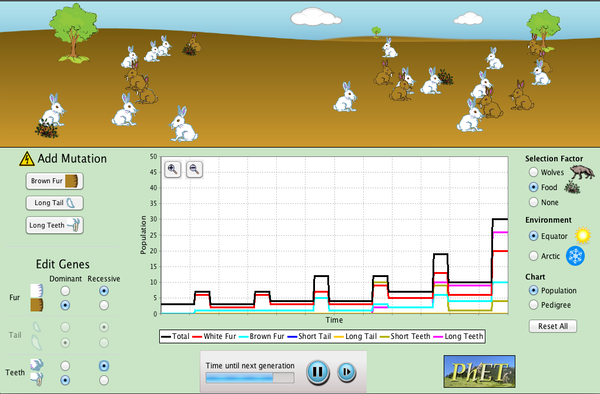Genes are the foundation for the diversity of living things
- How is DNA structured? What is the function of DNA?
- What are genes? What are Chromosomes?
- What are some of of the simple patterns of inheritance?
- What are the mechanisms for the diversity of life?
- How would you explain mutations and its impact on evolution?
- What is natural selection?
- What is artificial selection?
- What are the applications of genetics and what are the ethical considerations of genetics?
History of Genetics
DNA from the beginning: an animated primer of 75 experiments that made modern genetics
DNA Timeline (Guardian): From Mendel to the human genome project
DNA Timeline (Extension);
Part 1: DNA, Protein Synthesis and Mutations
DNA
Learn Genetics (University of Utah) “Build a DNA Molecule” – animation
5.Learn Genetics (UoU) – Lab Virtual DNA extraction ****
Video by Amoeba Sisters: DNA replication
Protein Synthesis
Learn Genetics – University of Utah “What are Proteins” – Video Clip
Learn Genetics – “Types of Proteins” – Animation
From DNA to Protein (Flash File animation) – learn how proteins are made in the cell from the information in the DNA codeYourgenome.org “From DNA to Protein” (flash)
Learn.Genetics “Transcribe and Translate a Gene”
Learn. Genetics “How do Cells Read Genes?
MUTATIONS
Learn. Genetics “What is Mutation?
Learn. Genetics “The Outcome of Mutation” – a mutation is a process that changes a DNA sequence
[youtube https://www.youtube.com/watch?v=11iYk0Yrx3g]
Bee Spotter – Honey Bee Genome
Learn more about the Bee Spotter Program
[youtube https://www.youtube.com/watch?v=Xpm8do76Xx4]
Part 2: Mendel Genetics
Mendelian Genetics Activity Page *****
[youtube https://www.youtube.com/watch?v=Mehz7tCxjSE]
Virtual Lab – Punnett squares (monohybrid genetic crosses)
12. Virtual Lab – How can sex-linked traits be identified?
Listen to a description of how local game farmers are breeding rare and unusual coloured game animals.
Learn more about how skin colour is a function of melanin presence which varies according to UV radiation.
[youtube https://www.youtube.com/watch?v=tLsFl6QiFh4]
Evolution Berkley HHMI – Videos/Comic Strip
Niche – the fun way to learn about natural selection
Learn a lot more about genes, chromosomes and mutations by exploring the learning links on our genetics page:
[youtube https://www.youtube.com/watch?v=Y0wSDpZodvI]
Learn more about how grassland creatures are about to co-exist due to niche partitioning. Each species is able to co-exist if it occupies a unique biological niche.
[youtube https://www.youtube.com/watch?v=8eH6X2rAQEs]
Part 1: Leading Activity/Introductory Activity: Science Museum “Do you want to know a secret?”
[youtube https://www.youtube.com/watch?v=kqf7FYfuqDc]
Student Activity/Mouse Clone Activity (Learn more about how to clone a mouse called mini)
[youtube https://www.youtube.com/watch?v=zlSTGkDyEfM]
[youtube https://www.youtube.com/watch?v=sH4bi60alZU]
[youtube https://www.youtube.com/watch?v=7TmcXYp8xu4]
DNA Sequencing = your entire genome
Genotyping = a tiny fraction of your genome (0.02% of your genome)
[youtube https://www.youtube.com/watch?v=U3EEmVfbKNs]
[youtube https://www.youtube.com/watch?v=r_qX0ghpleg]
[youtube https://www.youtube.com/watch?v=NkLeHnl-lPI]
Three main applications of genetics: GMOS, cloning, and stem cells.
Links:
Galapagos Adaptations Activity:
- Visit the Galapagos Animal Gallery (CLICK HERE!)
- Examine the photos of closely related species found in the Galapagos environment, including iguanas, tortoises, and cormorants.
- Observe the similarities and differences between the two species of each animal.
- Form hypotheses about species differences and the relationship to the environment of the Galapagos Islands. Use the habitat information below to help you:
- Habitat of…
